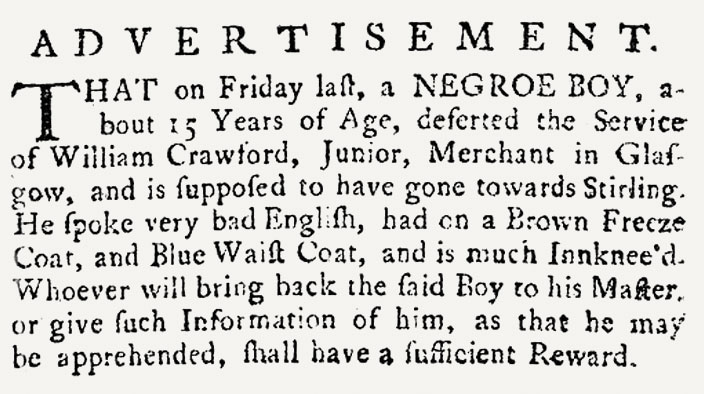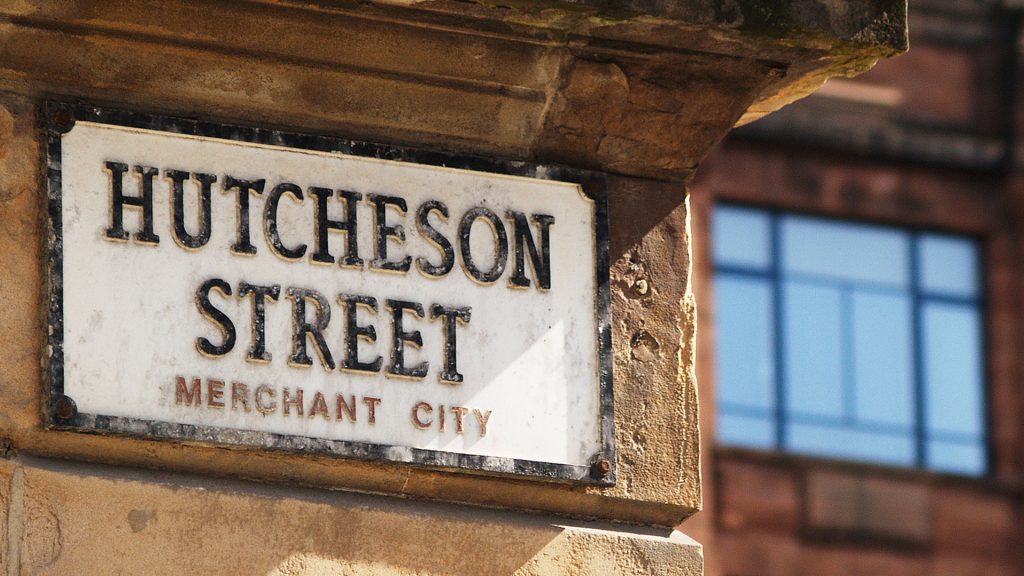Glasgow’s Built Heritage, Tobacco, the Slave Trade and Abolition
Hence, Commerce spreads her sails to a’
The Indies and America;
Whatever makes a penny twa,
By wind or tide,
Is wafted to the Broomielaw,
On bonny Clyde!
John Mayne (1759-1836) in Glasgow (1783).

Scotland’s role in the slave trade has long been a contentious issue. In modern times, a myth of denial has evolved. It has been almost casually accepted that ‘it wisnae us’.
This is due to a number of factors, not least a belief in a noble and heroic Scottish past. The popular history of the nation is often taken to be one of subjection, of a Scotland economically and politically subservient to the will of its larger neighbour. William Wallace, regularly lionised as the greatest of all our heroes, has been romanticised as dying in a vain but glorious attempt to free the nation from the English yoke.
It is all too easy to see the Scots as victims of oppression rather than as collaborators in the enslavement of nations. There are many unpalatable truths: Scots played a major role in the British Empire as doctors, administrators, lawyers, merchants, financiers and engineers but they were also prominent in trafficking human misery – in the trades in opium and slavery.

There have been various forms of denial regarding the role of Scots in the ‘Triangular Slave Trade’ between Africa and the New World. The level of Scots’ involvement has been disputed at all levels, including numbers of slave ships and the extent of the wealth produced through ‘chattel slavery’. One common misconception is that no slave ships left from Scottish ports. Underpinning disbelief and uncertainty until recently has been a lack of systematic research. It can now be shown that a number of ships with the principal aim of trading in slave cargoes cleared Scottish waters in the eighteenth century. In comparison with English ports, direct involvement in slave trading was minimal. But Glasgow and her merchants monopolised the two main goods produced by slaves – sugar and tobacco.
There are many reminders of this controversial past in daily view in Glasgow. The built heritage betrays much of this history in its street names, churches, graveyards and in the remains of Palladian mansions. That Glasgow benefited is indisputable. Yet, for all their culpability, Glaswegians also played a significant part in the abolition movement. A number of figures prominent in the Scottish Enlightenment took a strong stance. They were followed by churchmen and political campaigners. Individuals and organisations took up the cause and Glasgow became an integral part in a national campaign against the slave trade and slavery. This history, too, remains largely unknown and unacknowledged. This website examines the role of Glasgow, as both perpetrator and opponent of the ‘Horrible Traffik’ of slavery.

Read the history

View the built heritage
Union with England in 1707 removed the legal barriers that prevented Scotland from participating in trade with the New World. This allowed Scottish merchants access to new markets. By the mid eighteenth century, Glasgow dominated Britain’s tobacco and sugar imports. The city was also involved in the slave trade. Around nineteen slave ships left from Port Glasgow and Greenock, the city’s satellite ports. Many Scottish merchants also funded slave ships from other ports such as London, Bristol, Whitehaven and Liverpool, in what became known as the ‘triangular trade.’ British ships traded manufactured goods for slaves in Africa, and then on to slave plantations in America and the West Indies.
The direct trade with these colonies, the largest of which were in Virginia and Jamaica, led to major economic growth for Glasgow. Much praise has been heaped upon the merchant’s business acumen while the brutal reality, that sugar and tobacco were produced almost exclusively on slave labour, has been almost casually dismissed with a trite,“it wisnae us”. Only recently has the brutal truth of this episode in Glasgow’s economic past been examined and properly acknowledged.
The golden age of tobacco created the Tobacco Lords, who accumulated great wealth and became the Glasgow elite. They constructed townhouses, built churches, endowed public buildings and developed estates around the city that, even today, testify to their wealth. Some of these buildings are described in this website. They illustrate the opulence in which the Tobacco Lords lived from day to day, where they socialised and where they prayed. Exploring this history gives us an extraordinary insight into the role of slavery in Glasgow’s mercantile past.
It is ironic that a city that developed through plantation economics should play a major role in the abolition of slavery. ‘The Glasgow Enlightenment’ produced a powerful and sustained critique that inspired abolitionists across the globe. Anti-slavery societies grew up across Great Britain and, in spite of vested interests, Glasgow became an influential centre for political agitation. The built heritage of Glasgow also illustrates how individuals and organisations worked towards the abolition of the evil of slavery.
The map below gives a historical journey of discovery that highlights the largely untold story of Glasgow and slavery.

About this project

This website is based on the book It Wisnae Us: The Truth About Glasgow and Slavery by Stephen Mullen, published by the Royal Incorporation of Architects in Scotland on behalf of Glasgow Anti Racist Alliance (now the Coalition for Racial Equality and Rights – CRER) in 2009. An exhibition and trail guide were also produced.
As the book is out-of-print and no longer available, it was felt that the important subject matter should be made available online for a wider audience.
This website has been created by Jon Jardine, the designer of the original book, exhibition and trail guide. He has not taken a fee for this. Many thanks to all those who have agreed to provide this material online.
The photographs and illustrations throughout this website were generously provided by Alan Crumlish, Jon Jardine, Charles McKean and The Mitchell Library (Culture and Sport Glasgow).
There are also a number of illustrations from early sources which give at least some insight into the treatment and conditions suffered by slaves. Every effort has been made to obtain copyright clearance on all the images within the original book and thus this website.